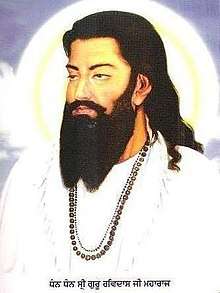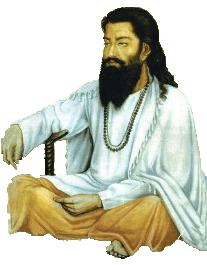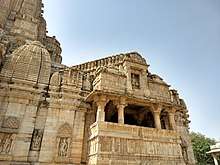Ravidas
Ravidas was an Indian mystic poet-sant of the Bhakti movement during the 15th to 16th century CE.[3][4] Venerated as a guru (teacher) in the region of Uttar Pradesh, Rajasthan, Maharashtra, Madhya Pradesh and mainly Punjab. He was a poet-saint, social reformer and a spiritual figure.
Ravidas | |
|---|---|
 Ravidas | |
| Born | c. 1450[1][2] |
| Died | c. 1520[1][2] |
Notable work | Founding Ravidassia faith |
| Honors | Venerated as a Guru and having hymns included in the Guru Granth Sahib |
| Ecclesiastical career | |
| Religion | Hinduism |
| Part of a series on the |
| Ravidas Panth |
|---|
 |
| Beliefs and practices |
|
| Temples |
|
| Scriptures |
| Holy Places |
| Founder |
|
| Sants |
| Festivals |
| Symbols |
 |
| Part of a series on |
| Sikhism |
|---|
 |
|
|
Practices
|
|
|
General topics
|
The life details of Ravidas are uncertain and contested. Scholars believe he was born in 1450 CE,[1] in a family that worked with dead animals' skins to produce leather products.[3][4]
Ravidas's devotional songs were included in the Sikh scriptures known as Guru Granth Sahib.[4][5] The Panch Vani text of the Dadupanthi tradition within Hinduism also includes numerous poems of Ravidas.[3] He taught removal of social divisions of caste and gender, and promoted unity in the pursuit of personal spiritual freedoms.
Life
The details of Ravidas's life are not well known. Scholars state he was born in 1450 CE and died in 1520 CE.[1][6]
Ravidas was born in the village of Seer Goverdhanpur, near Varanasi in what is now Uttar Pradesh, India. His birthplace is now known as Shri Guru Ravidas Janam Asthan. Mata Kalsa’n was his mother, and his father was Santokh Dass.[7] His parents belonged to a leather-working Chamar community making them an untouchable caste.[3][4] While his original occupation was leather work, he began to spend most of his time in spiritual pursuits at the banks of the Ganges. Thereafter he spent most of his life in the company of Sufi saints, sadhus and ascetics.[7]
The text Anantadas Parcai is one of the earliest surviving biographies of various Bhakti movement poets which talks about the birth of Ravidas.[8]
Medieval era texts, such as the Bhaktamal suggest that Ravidas was not the disciple of the Brahmin bhakti-poet Ramananda.[9][10] He is traditionally considered as Kabir's younger contemporary.[3]
However, the medieval text titled Ratnavali says Ravidas gained his spiritual knowledge from Ramananda and was a follower of the Ramanandi Sampradaya tradition.[11][9][10]
His ideas and fame grew over his lifetime, and texts suggest Brahmins (members of priestly upper caste) used to bow before him.[4] He travelled extensively, visiting Hindu pilgrimage sites in Andhra Pradesh, Maharashtra, Gujarat, Rajasthan and those in the Himalayas. He abandoned saguna (with attributes, image) forms of supreme beings, and focussed on the nirguna (without attributes, abstract) form of supreme beings.[7] As his poetic hymns in regional languages inspired others, people from various background sought his teachings and guidance.[7]
Most scholars believe that Ravidas met Guru Nanak, the founder of Sikhism.[4] He is revered in the Sikh scripture, and 41 of Ravidas' poems are included in the Adi Granth. These poems are one of the oldest attested source of his ideas and literary works.[3][4] Another substantial source of legends and stories about the life of Ravidas is the hagiography in the Sikh tradition, named Premambodha.[12] This text, composed over 150 years after Ravidas' death, in 1693, includes him as one of the seventeen saints of Indian religious tradition.[12] The 17th-century Nabhadas's Bhaktamal, and the Parcais of Anantadas, both contain chapters on Ravidas.[13] Other than these, the scriptures and texts of Sikh tradition and the Hindu Dadupanthi traditions, most other written sources about the life of Ravidas, including by the Ravidasi (followers of Ravidas), were composed in the early 20th century, or about 400 years after his death.[12]
[14] This text, called the Parcaīs (or Parchais), included Ravidas among the sants whose biography and poems were included. Over time new manuscripts of Parcais of Anantadas were reproduced, some in different local languages of India.[14] Winnand Callewaert notes that some 30 manuscripts of Anantadas's hagiography on Ravidas have been found in different parts of India.[15] Of these four manuscripts are complete, collated and have been dated to 1662, 1665, 1676 and 1687. The first three are close with some morphological variants without affecting the meaning, but the 1687 version systematically inserts verses into the text, at various locations, with caste-related statements, new claims of Brahmins persecuting Ravidas, notes on the untouchability of Ravidas, claims of Kabir giving Ravidas ideas, ridicules of nirguni and saguni ideas, and such text corruption:[16] Callewaert considers the 1676 version as the standard version, his critical edition of Ravidas's hagiography excludes all these insertions, and he remarks that the cleaner critical version of Anantadas's parcais suggests that there is more in common in the ideas of bhakti movement's Ravidas, Kabir and Sen than previously thought.[15]
Khare similarly has questioned the textual sources on Ravidas, and mentions there are few "readily available and reliable textual sources on the Hindu and Untouchable treatment of Ravidas."[17]
Literary works
The Adi Granth of Sikhs, and Panchvani of the Hindu warrior-ascetic group Dadupanthis are the two oldest attested sources of the literary works of Ravidas.[3] In the Adi Granth, forty of Ravidas's poems are included, and he is one of thirty six contributors to this foremost canonical scripture of Sikhism.[18][19] This compilation of poetry in Adi Granth responds to, among other things, issues of dealing with conflict and tyranny, war and resolution, and willingness to dedicate one's life to the right cause.[18] Ravidas's poetry covers topics such as the definition of a just state where there are no second or third class unequal citizens, the need for dispassion, and who is a real Yogi.[19][20]
Jeffrey Ebbesen notes that, just like other bhakti saint-poets of India and some cases of Western literature authorship, many poems composed by later era Indian poets have been attributed to Ravidas, as an act of reverence, even though Ravidas has had nothing to do with these poems or ideas expressed therein.[21]
Ravidas literature on symbolism
Peter Friedlander states that Ravidas' hagiographies, though authored long after he died, depict a struggle within the Indian society, where Ravidas' life gives the means to express a variety of social and spiritual themes.[12] At one level, it depicts a struggle between the then prevalent heterodox communities and the orthodox Brahminical tradition. At another level, the legends are an inter-communal, inter-religious struggle with an underlying search and desire for social unity. At yet another level, states Friedlander, the stories describe the spiritual struggle of an individual unto self.[12]
There is no historical evidence to verify the historicity in these hagiographies, which range from Ravidas's struggle with Hindu Brahmins,[22] to his struggle with Muslim Sultan Sikander Lodi.[23] Friedlander states that the stories reflect the social dynamics that influenced the composers of the hagiographies during the 17th- to 20th-century. These are legends where Ravidas is victorious because God intervened with miracles such as making a stone float in water, or making river Ganges to reverse course and flow upstream.[12]
David Lorenzen similarly states that poetry attributed to Ravidas, and championed by Ravidasi (his followers) from the 17th- through the 20th-century, have a strong anti-Brahminical and anti-communal theme.[24] The legends, suggests Lorenzen, cannot be separated from the power and political situation of this era, and they reflect a strong element of social and religious dissent by groups marginalised during a period when Indian society was under the Islamic rule and later the colonial rule.[24][25]
Philosophy
The songs of Ravidas discuss Nirguna-Saguna themes, as well as ideas that are at the foundation of Nath Yoga philosophy of Hinduism.[26] He frequently mentions the term Sahaj, a mystical state where there is a union of the truths of the many and the one.[26]
Raidas says, what shall I sing?
Singing, singing I am defeated.
How long shall I consider and proclaim:
absorb the self into the Self?
This experience is such,
that it defies all description.
I have met the Lord,
Who can cause me harm?
Hari in everything, everything in Hari –
For him who knows Hari and the sense of self,
no other testimony is needed:
the knower is absorbed.— Ravidas, Translated by Winand Callewaert and Peter Friedlander[26]
David Lorenzen states Ravidas's poetry is imbued with themes of boundless loving devotion to God, wherein this divine is envisioned as Nirguna.[27] In the Sikh tradition, the themes of Nanak's poetry are very broadly similar to the Nirgun bhakti ideas of Ravidas and other leading north Indian saint-poets.[25][28] Most postmodern scholars, states Karen Pechilis, consider Ravidas's ideas to belong to the Nirguna philosophy within the bhakti movement.[29]
Monistic Brahman or Anthropomorphic God
Multiple manuscripts found in Rajasthan and Uttar Pradesh, dated to be from the 18th and 19th centuries, contain a theosophical debate between Kabir and Ravidas on the nature of the Absolute, more specifically whether the Brahman (Ultimate Reality, Eternal Truth) is monistic Oneness or a separate anthropomorphic incarnate.[30] Kabir argues for the former. Ravidas, in contrast, argues from the latter premise to the effect that both are one.[30] In these manuscripts, Kabir initially prevails, Ravidas accepts that Brahman is monistic, but till the end Kabir didn't accept worshipping a divine avatar (sagun conception).[30]
One man: two divergent claims on his views and philosophy
Ravindra Khare[31] states that there are two divergent versions that emerge from the study of texts relating to Ravidas's philosophy. The 17th century Bhaktamal text by Nabhadas provides one version, while the 20th-century texts by Dalits (the modern term for those previously called "untouchables") provide another.[17]
According to Bhaktamal text, Ravidas was of pure speech, capable of resolving spiritual doubts of those who held discussions with him, was unafraid to state his humble origins and real caste.[32] Further, the Bhaktamal text states that Ravidas's teachings agreed with Vedic and ancient scriptures, he subscribed to nondualism, discussed spiritual ideas and philosophy with everyone including Brahmins without gender or caste discrimination, and his abilities reflected an individual who had reached the inner content state of the highest ascetic.[32]
The 20th-century version, prevalent in the texts of Dalit community, concurs with the parts about pure speech and resolving spiritual doubts.[33] However, they differ in the rest. The texts and the prevalent beliefs of the Dalit community hold that Ravidas rejected the Hindu Vedas, he was opposed by the Brahmins and resisted by the caste Hindus as well as Hindu ascetics throughout his life, and that some members of the Dalit community have believed Ravidas was an idol worshipper (saguni bhakti saint) while other 20th century texts assert that Ravidas rejected idolatry.[33] For example, the following hymn of Ravidas, present in Guru Granth Sahib, support such claims where he rejects Vedas and the belief that taking a ritualistic bath can make someone pure.
One may distinguish between good and evil actions, and listen to the Vedas and the Puraanas, but doubt still persists. Skepticism continually dwells in the heart, so who can eradicate egotistical pride? Outwardly, he washes with water, but deep within, his heart is tarnished by all sorts of vices. So how can he become pure? His method of purification is like that of an elephant, covering himself with dust right after his bath!
— Ravidas, Guru Granth Sahib 346 [34]
Legacy
Ravidassia religion
The difference between the Ravidassia religion and Sikhism, as described by a post made by Shri Guru Ravidass Temple in Ontario is as follows:
We, as Ravidassias have different traditions. We are not Sikhs. Even though, we give utmost respect to 10 gurus and Guru Granth Sahib, Guru Ravidass Ji is our supreme. There is no command for us to follow the declaration that there is no Guru after Guru Granth Sahib. We respect Guru Granth Sahib because it has our guru Ji's teachings and teachings of other religious figures who have spoken against caste system, spread the message of NAAM and equality. As per our traditions, we give utmost respect to contemporary gurus also who are carrying forward the message of Guru Ravidass Ji.[35]
Ravidassia religion is a spin-off religion from Sikhism, formed in the 21st century, by the followers of Ravidass's teachings. It was formed following the murder of their cleric Ramanand Dass in Vienna in 2009, where the movement declared itself to be a religion fully separated from Sikhism.[36] The Ravidassia religion compiled a new holy book, Amritbani Guru Ravidass Ji. Based entirely on the writings and teaching of Ravidas, it contains 240 hymns. Sant Niranjan Dass is the head of Dera Sachkhand Ballan.[36]
Kathryn Lum summarises the dynamics behind the separation of Ravidassia religion and Sikhism, and its focus on Ravidas, as follows:
Ravidasia believe that the best way forward for Chamars is to claim and assert their own identity. For this more independent camp, Sikhism is viewed as obstructing the full development of the Chamar community as a quam (separate religion and nation), as envisioned by the Ad Dharm (original people) movement. According to these separatist Ravidasias, the only way for Chamars to progress is to pursue an independent religious path focused exclusively on the figure of Guru Ravidas.
— Kathryn Lum, Sikhs in Europe[37]
Places of worship

Ravidas is revered as a saint and well respected by his believers. He is considered by his devotees as someone who was the living symbol of religious protest, and not as the spiritual symbol of any ultimate unifying cultural principle.[38]
Politics
.jpg)
A political party was founded in India in 2012 by the followers of Ravidass, with the word Begumpura (Be-gam-pura, or "land without sorrow"), a term coined in a poem by Ravidas. The term means the city where there is no suffering or fear, and all are equal.[39]
Guru Ravidas and Bhagtani Meera Bai

There is a small chhatri (umbrella) in front of Meera's temple in Chittorgarh district of Rajasthan which bears Ravidas' engraved foot print.[40] Legends link him as the guru of Meera, another major Bhakti movement poet.[26]
References
- Arvind Sharma (2003), The Study of Hinduism, The University of South Carolina Press, ISBN 978-1570034497, page 229
- Phyllis G. Jestice (2004). Holy People of the World: A Cross-Cultural Encyclopedia. ABC-CLIO. p. 724. ISBN 978-1-57607-355-1.
- James Lochtefeld (2002), The Illustrated Encyclopedia of Hinduism: N-Z, Rosen Publishing, ISBN 978-0823931804, page 569
- "Bhagat Ravidass Ji (Indian mystic and poet) – Britannica Online Encyclopedia". Britannica.com. Retrieved 10 August 2009.
- Callewaert and Friedlander, The Life and Works of Ravidass Ji, Manohar, Delhi, 1992, quoted in Gavin Flood, An Introduction to Hinduism, Cambridge 1996.
- Phyllis G. Jestice (2004). Holy People of the World: A Cross-Cultural Encyclopedia. ABC-CLIO. pp. 727–728. ISBN 978-1-57607-355-1. Retrieved 8 December 2012.
- Hardev Bahri. Harbans Singh; et al. (eds.). "Ravidas". Encyclopaedia of Sikhism. Punjabi University Patiala. Retrieved 11 February 2017.
- Callewaert, Winnand (2013). The Hagiographies of Anantadas: The Bhakti Poets of North India. Routledge. pp. 307, 1–23. ISBN 9781136120022.
- Pande, Rekha (2010). Divine Sounds from the Heart—Singing Unfettered in their Own Voices: The Bhakti Movement and its Women Saints (12th to 17th Century). Cambridge Scholars Publishing. p. 76–77. ISBN 9781443825252. Retrieved 25 August 2019.
- David Lorenzen (1996), Praises to a Formless God: Nirguni Texts from North India, State University of New York Press, ISBN 978-0791428054, page 268
- Mamta Jha (2013). Sant Ravidas Ratnawali. prabhat prakashan. p. 12.
- Peter Friedlander (1996), Myth and Mythmaking: Continuous Evolution in Indian Tradition (Editor: Julia Leslie), Routledge, ISBN 978-0700703036, pages 106-114
- Winnand Callewaert (2000), The Hagiographies of Anantadas: The Bhakti Poets of North India, Routledge, ISBN 978-0700713318, pages 1-4
- Callewaert, Winand. (2003), Pilgrims, Patrons, and Place: Localizing Sanctity in Asian Religions (Editors: Phyllis Granoff and Koichi Shinohara), University of British Columbia Press, ISBN 978-0774810395, pages 203-223
- Winnand Callewaert (2000), The Hagiographies of Anantadas: The Bhakti Poets of North India, Routledge, ISBN 978-0700713318, pages 303-307
- Winnand Callewaert (2000), The Hagiographies of Anantadas: The Bhakti Poets of North India, Routledge, ISBN 978-0700713318, pages 316-334
- Ravindra S Khare (1985), The Untouchable as Himself, Cambridge University Press, ISBN 978-0521263146, pages 41-47
- Pashaura Singh (2012), Fighting Words: Religion, Violence, and the Interpretation of Sacred Texts (Editor: John Renard), University of California Press, ISBN 978-0520274198, pages 202-207
- GS Chauhan (2009), Bani Of Bhagats, Hemkunt Press, ISBN 978-8170103561, pages 41-55
- J Kaur (2005), The Concept of Peace and the Guru Granth Sahib, The Indian Journal of Political Science, Volume 66, Number 3, pages 649-660
- Jeffrey Ebbesen (1995), Literary India: Comparative Studies in Aesthetics, Colonialism, and Culture (Editors: Patrick Colm Hogan, Lalita Pandit), State University of New York Press, ISBN 978-0791423950, pages 53-55
- Peter Friedlander (1996), Myth and Mythmaking: Continuous Evolution in Indian Tradition (Editor: Julia Leslie), Routledge, ISBN 978-0700703036, pages 109-110
- Peter Friedlander (1996), Myth and Mythmaking: Continuous Evolution in Indian Tradition (Editor: Julia Leslie), Routledge, ISBN 978-0700703036, pages 108, 112-117
- David Lorenzen (1995), Bhakti Religion in North India: Community Identity and Political Action, State University of New York Press, ISBN 978-0791420256, pages 105-116, 292-303
- Neeti M Sadarangani (2004), Bhakti Poetry in Medieval India: Its Inception, Cultural Encounter and Impact, Swarup & Sons, ISBN 978-8176254366, pages i-xv, 115, 55-60, 72-76
- Peter Heehs (2002), Indian Religions: A Historical Reader of Spiritual Expression and Experience, New York University Press, ISBN 978-0814736500, pages 368-370
- David Lorenzen (1995), Bhakti Religion in North India: Community Identity and Political Action, State University of New York Press, ISBN 978-0791420256, page 107
- Christopher Shackle (2014), The Oxford Handbook of Sikh Studies (Editors: Pashaura Singh, Louis E. Fenech), Oxford University Press, ISBN 978-0199699308, page 111
- Karen Pechilis Prentiss (2014), The Embodiment of Bhakti, Oxford University Press, ISBN 978-0195351903, page 21
- David Lorenzen (1996), Praises to a Formless God: Nirguni Texts from North India, State University of New York Press, ISBN 978-0791428054, pages 169-170
- Ravindra S Khare (1985), The Untouchable as Himself, Cambridge University Press, ISBN 978-0521263146, pages 41, 46
- Ravindra S Khare (1985), The Untouchable as Himself, Cambridge University Press, ISBN 978-0521263146, pages 41-45
- Ravindra S Khare (1985), The Untouchable as Himself, Cambridge University Press, ISBN 978-0521263146, pages 46-53, 163-164
- "Sri Granth: Sri Guru Granth Sahib".
- Ram, R. (2009). Ravidass, Dera Sachkhand Ballan and the Question of Dalit Identity in Punjab. JPS, 16(1), 2.
- "Punjab sect declares new religion". The Times of India. 1 February 2010.
- Kathryn Lum (2011), Sikhs in Europe: Migration, Identities, and Representations (Editors: Knut A Jacobsen and Kristina Myrvold), Ashgate, ISBN 978-1409424345, page 186
- Ravindra S Khare (1985), The Untouchable as Himself, Cambridge University Press, ISBN 978-0521263146, pages 48-49, 41-53
- Omvedt, Gail (2009). Seeking Begumpura : The Social Vision of Anticaste Intellectuals. Navayana. ISBN 978-8189059453.
- Chittauragarh Fort: An Enigma with a Thin Line between History and Mythology. 24 August 2009, Ghumakkar.com
